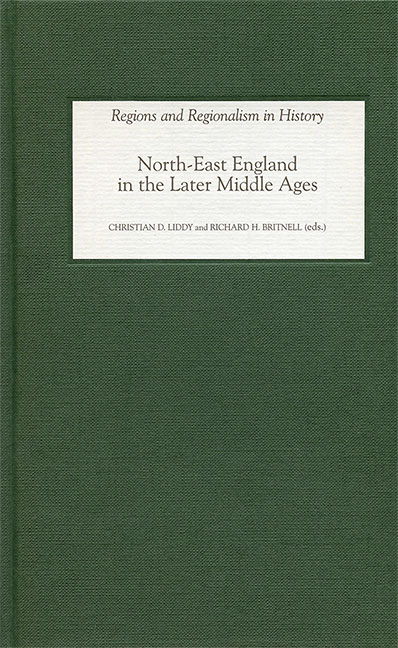Book contents
- Frontmatter
- Contents
- List of Illustrations
- Contributors
- Preface
- Abbreviations
- Introduction
- 1 St Cuthbert and the Border, c.1080–c.1300
- 2 John Hardyng, Northumbrian Identity and the Scots
- 3 Remembering the Legal Past: Anglo-Scottish Border Law and Practice in the Later Middle Ages
- 4 Scaling the Ladder: The Rise and Rise of the Grays of Heaton, c.1296–c.1415
- 5 Land, Legend and Gentility in the Palatinate of Durham: The Pollards of Pollard Hall
- 6 Local Law Courts in Late Medieval Durham
- 7 The Free Court of the Priors of Durham
- 8 Church Discipline in Late Medieval Durham City: The Prior as Archdeacon
- 9 Economy and Society in North-Eastern Market Towns: Darlington and Northallerton in the Later Middle Ages
- 10 Newcastle Trade and Durham Priory, 1460–1520
- 11 The Size and Shape of Durham’s Monastic Community, 1274–1539
- 12 Peasants, Landlords and Production between the Tyne and the Tees, 1349–1450
- 13 Wastes, the Margins and the Abandonment of Land: The Bishop of Durham’s Estate, 1350–1480
- 14 Framing Medieval Landscapes: Region and Place in County Durham
- Index
14 - Framing Medieval Landscapes: Region and Place in County Durham
Published online by Cambridge University Press: 23 March 2023
- Frontmatter
- Contents
- List of Illustrations
- Contributors
- Preface
- Abbreviations
- Introduction
- 1 St Cuthbert and the Border, c.1080–c.1300
- 2 John Hardyng, Northumbrian Identity and the Scots
- 3 Remembering the Legal Past: Anglo-Scottish Border Law and Practice in the Later Middle Ages
- 4 Scaling the Ladder: The Rise and Rise of the Grays of Heaton, c.1296–c.1415
- 5 Land, Legend and Gentility in the Palatinate of Durham: The Pollards of Pollard Hall
- 6 Local Law Courts in Late Medieval Durham
- 7 The Free Court of the Priors of Durham
- 8 Church Discipline in Late Medieval Durham City: The Prior as Archdeacon
- 9 Economy and Society in North-Eastern Market Towns: Darlington and Northallerton in the Later Middle Ages
- 10 Newcastle Trade and Durham Priory, 1460–1520
- 11 The Size and Shape of Durham’s Monastic Community, 1274–1539
- 12 Peasants, Landlords and Production between the Tyne and the Tees, 1349–1450
- 13 Wastes, the Margins and the Abandonment of Land: The Bishop of Durham’s Estate, 1350–1480
- 14 Framing Medieval Landscapes: Region and Place in County Durham
- Index
Summary
All history involves the creation of viable balances between detail, seen for instance in the minutiae of an individual land charter – the legitimate subject of a single learned paper by a historian – and the broader sweeps of regional and national contexts. To create the latter, broad brush representations necessarily replace the finely grained textures. This contrast is to be seen in the antithesis between the Spanish fighting bull, all rush and testosterone, found in a few strokes from Picasso, and the meticulous and bejewelled detail of an artist such as van Eyck. In art, and history, there is a place for both. This essay uses work by the three authors in order to sketch some broad brush lines concerning the medieval landscapes of County Durham.
The land itself and its adjacent sea, a complex of geology, relief, soils, vegetation and water, locked together within frames defined by latitude and longitude, have always been the setting for local human affairs. Clearance and farming, building and destruction, management and usage have all played a part, with each generation maintaining, altering and sometimes destroying the cultural landscapes inherited from previous generations: an endless succession, paradoxically involving both stability and change. One indicator of the problems involved when dealing with historic landscapes is to be seen in field observations of portions of the boundary banks of Steward Shield Meadow (map 14.4). On the eastern side of the site these have actually been cut away by valley-side retreat, itself the result of increased run-off occasioned by woodland clearance and the grazing of many beasts. We know that the site was deserted by the later fourteenth century and the banks can be seen as ‘medieval’. They probably were, and the interpretation of the site as an eighty-acre moorland farm (see below and map 14.4) is reasonable. However, the fact that the pollen diagram shows that the major clearance took place long before this date leaves other options open amid a mere sixty-two centimetres of muddy peat: we cannot, without extensive excavation, prove that the banks are not Romano-British or prehistoric. The problem is one of correlating evidence that can disappear through the fingers like dry sand.
- Type
- Chapter
- Information
- North-East England in the Later Middle Ages , pp. 221 - 238Publisher: Boydell & BrewerPrint publication year: 2005

